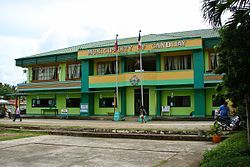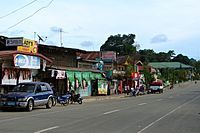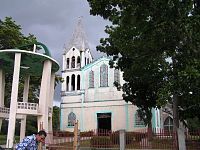Candijay
This article needs additional citations for verification. (October 2013) |
Candijay | |
|---|---|
| Municipality of Candijay | |
 Candijay Town Hall | |
 Map of Bohol with Candijay highlighted | |
Location within the Philippines | |
| Coordinates: 9°49′05″N 124°29′46″E / 9.818°N 124.496°E | |
| Country | Philippines |
| Region | Central Visayas |
| Province | Bohol |
| District | 3rd district |
| Founded | 29 November 1854 |
| Barangays | 21 (see Barangays) |
| Government | |
| • Type | Sangguniang Bayan |
| • Mayor | Thamar Olaivar |
| • Vice Mayor | Christopher Tutor |
| • Representative | Kristine Alexie B. Tutor |
| • Municipal Council | Members |
| • Electorate | 21,628 voters (2022) |
| Area | |
• Total | 103.26 km2 (39.87 sq mi) |
| Elevation | 17.8 m (58.4 ft) |
| Highest elevation | 346 m (1,135 ft) |
| Lowest elevation | −1 m (−3 ft) |
| Population (2020 census)[4] | |
• Total | 30,119 |
| • Density | 290/km2 (760/sq mi) |
| • Households | 7,214 |
| Economy | |
| • Income class | 4th municipal income class |
| • Poverty incidence | 25.58 |
| • Revenue | ₱ 128.2 million (2020), 60.22 million (2012), 62.98 million (2013), 71.7 million (2014), 81.46 million (2015), 92.63 million (2016), 110.6 million (2017), 149.1 million (2018), 116.8 million (2019), 137.8 million (2021), 180 million (2022) |
| • Assets | ₱ 229 million (2020), 70.93 million (2012), 85.86 million (2013), 86.16 million (2014), 101.2 million (2015), 147.5 million (2016), 177.5 million (2017), 177.1 million (2018), 214.6 million (2019), 236 million (2021), 285.4 million (2022) |
| • Expenditure | ₱ 103 million (2020), 51.33 million (2012), 52.97 million (2013), 57.95 million (2014), 64.46 million (2015), 71.96 million (2016), 92.07 million (2017), 138 million (2018), 103.5 million (2019), 123.9 million (2021), 138.1 million (2022) |
| • Liabilities | ₱ 57.88 million (2020), 8.731 million (2012), 4.902 million (2013), 8.715 million (2014), 17.48 million (2015), 46.98 million (2016), 59.21 million (2017), 59.15 million (2018), 50.76 million (2019), 186.3 million (2021), 53.67 million (2022) |
| Service provider | |
| • Electricity | Bohol 2 Electric Cooperative (BOHECO 2) |
| Time zone | UTC+8 (PST) |
| ZIP code | 6312 |
| PSGC | |
| IDD : area code | +63 (0)38 |
| Native languages | Boholano dialect Cebuano Tagalog |
| Website | candijay-bohol |
Candijay, officially the Municipality of Candijay (Cebuano: Munisipyo sa Candijay; Tagalog: Bayan ng Candijay), is a municipality in the province of Bohol, Philippines. According to the 2020 census, it has a population of 30,119 people.[4]
Candijay is home to the Bohol Island State University (BISU), which offers college courses related to Fishery Science, Teacher Education, Business and Management, and other science-related programs. It also has educational facilities for elementary and secondary levels in almost all barangays of the municipality.
History
[edit]The name of the town is said to have come from the words "Kang Dihay" meaning belonging to Dihay, a strong man with many followers. The name was eventually changed to Candijay and was organized during the Spanish regime and was then one of the 34 towns in the province in 1879 with a population of 5,030.
The municipality of Candijay was one of the 34 towns established during the Spanish regime in 1879 and so was its establishment as a parish.[6] The people were eventually converted to the Roman Catholic religion by the Spaniards. The parochial church of Candijay is dedicated to Saint Joseph whose feast day is 19 May.
Geography
[edit]Candijay is located on the eastern side of Bohol, 97 kilometres (60 mi) from Tagbilaran. The town has a land area of 8,687 hectares (21,470 acres).
The town faces Cogtong Bay which has the most diverse mangrove ecosystem in Bohol. The bay is home to 32 of the Philippines' 47 species of mangroves and associates. Yet due to illegal fishing and mismanagement of the mangroves, the mangroves and marine life in the area dwindled. To rectify the damage done, the municipal government is now engaged in a coastal resource management program: the planting of mangroves, though the control and eventual abolition of illegal fishing has yet to be addressed.
Barangays
[edit]Candijay is politically subdivided into 21 barangays. Each barangay consists of puroks and some have sitios.
| PSGC | Barangay | Population | ±% p.a. | |||
|---|---|---|---|---|---|---|
| 2020[4] | 2010[7] | |||||
| 071211001 | Abihilan | 5.3% | 1,603 | 1,209 | 2.86% | |
| 071211002 | Anoling | 3.7% | 1,113 | 1,114 | −0.01% | |
| 071211003 | Boyo‑an | 5.3% | 1,610 | 1,612 | −0.01% | |
| 071211004 | Cadapdapan | 4.2% | 1,273 | 1,381 | −0.81% | |
| 071211005 | Cambane | 1.4% | 416 | 435 | −0.45% | |
| 071211006 | Can‑olin | 7.2% | 2,155 | 2,215 | −0.27% | |
| 071211007 | Canawa | 4.5% | 1,370 | 1,415 | −0.32% | |
| 071211008 | Cogtong | 8.6% | 2,605 | 2,492 | 0.44% | |
| 071211009 | La Union | 4.8% | 1,449 | 1,365 | 0.60% | |
| 071211010 | Luan | 2.4% | 731 | 886 | −1.90% | |
| 071211011 | Lungsoda‑an | 5.0% | 1,499 | 1,461 | 0.26% | |
| 071211012 | Mahangin | 3.0% | 891 | 906 | −0.17% | |
| 071211013 | Pagahat | 2.2% | 669 | 1,000 | −3.94% | |
| 071211014 | Panadtaran | 3.2% | 969 | 1,002 | −0.33% | |
| 071211015 | Panas | 5.6% | 1,675 | 1,477 | 1.27% | |
| 071211016 | Poblacion | 11.4% | 3,421 | 3,344 | 0.23% | |
| 071211017 | San Isidro | 3.7% | 1,124 | 1,042 | 0.76% | |
| 071211018 | Tambongan | 5.1% | 1,542 | 1,587 | −0.29% | |
| 071211019 | Tawid | 3.6% | 1,090 | 1,089 | 0.01% | |
| 071211022 | Tubod (Tres Rosas) | 2.9% | 888 | 928 | −0.44% | |
| 071211021 | Tugas | 5.5% | 1,650 | 1,640 | 0.06% | |
| Total | 30,119 | 29,043 | 0.36% | |||
Climate
[edit]| Climate data for Candijay, Bohol | |||||||||||||
|---|---|---|---|---|---|---|---|---|---|---|---|---|---|
| Month | Jan | Feb | Mar | Apr | May | Jun | Jul | Aug | Sep | Oct | Nov | Dec | Year |
| Mean daily maximum °C (°F) | 28 (82) |
29 (84) |
30 (86) |
31 (88) |
31 (88) |
30 (86) |
30 (86) |
30 (86) |
30 (86) |
29 (84) |
29 (84) |
29 (84) |
30 (85) |
| Mean daily minimum °C (°F) | 23 (73) |
22 (72) |
23 (73) |
23 (73) |
24 (75) |
25 (77) |
24 (75) |
24 (75) |
24 (75) |
24 (75) |
23 (73) |
23 (73) |
24 (74) |
| Average precipitation mm (inches) | 102 (4.0) |
85 (3.3) |
91 (3.6) |
75 (3.0) |
110 (4.3) |
141 (5.6) |
121 (4.8) |
107 (4.2) |
111 (4.4) |
144 (5.7) |
169 (6.7) |
139 (5.5) |
1,395 (55.1) |
| Average rainy days | 18.6 | 14.8 | 16.5 | 16.7 | 23.9 | 26.4 | 25.6 | 24.1 | 24.4 | 26.3 | 23.7 | 20.5 | 261.5 |
| Source: Meteoblue (Use with caution: this is modeled/calculated data, not measured locally.)[8] | |||||||||||||
Demographics
[edit]| Year | Pop. | ±% p.a. |
|---|---|---|
| 1903 | 6,522 | — |
| 1918 | 8,372 | +1.68% |
| 1939 | 13,749 | +2.39% |
| 1948 | 15,658 | +1.46% |
| 1960 | 16,035 | +0.20% |
| 1970 | 17,114 | +0.65% |
| 1975 | 19,750 | +2.91% |
| 1980 | 21,342 | +1.56% |
| 1990 | 26,102 | +2.03% |
| 1995 | 25,729 | −0.27% |
| 2000 | 30,389 | +3.63% |
| 2007 | 31,183 | +0.36% |
| 2010 | 29,043 | −2.55% |
| 2015 | 29,475 | +0.28% |
| 2020 | 30,119 | +0.43% |
| Source: Philippine Statistics Authority[9][7][10][11] | ||
Economy
[edit]Poverty incidence of Candijay
10
20
30
40
50
60
2006
38.00 2009
52.29 2012
34.50 2015
28.36 2018
21.40 2021
25.58 Source: Philippine Statistics Authority[12][13][14][15][16][17][18][19] |
Tourism
[edit]Candijay has several natural resources. Among these which consequently are visited by both foreign and local tourists are the Can‑umantad Falls which is still being developed, the pristine cold spring Canawa Spring, in Canawa and the Kawasihan Islet Sand Bar in Panas.
There are also some potential eco-tourism destination which consequently start to attract visitors such as the Layog Caves in Luan, Sangat Cave in Tambongan and Ilaja Cave in Panas; the hinterland rice terraces in Tambongan, Canawa, Cadapdapan, Tubod and Abihilan; Danicop Gorge Brook in Cambane; the Kantaligsok Peak which is said to be the tallest peak found in Tugas; as well as the Candijay Mangrove Forests in Panadtaran. The community-based Panadtaran Mangrove Association (PAMAS), which seeks to preserve Panadtaran's mangroves and other natural resources in the area and promote them for eco-tourism pursuits, has now established the Candijay Mangrove Adventure Tour.
Candijay also boasts a man-made lake known as Boongon SWI.
Education
[edit]-
- Anoling National High School
- Bohol Island State University - Candijay Campus, Teacher Education Laboratory High School
- Candijay National High School
- Cogtong National High School
- La Union National High School
- Saint Joseph Academy
- Tambongan National High School
-
- Abihilan Elementary School
- Anoling Elementary School
- Boy‑oan Elementary School
- Cadapdapan Elementary School
- Cambane Elementary School
- Canawa Elementary School
- Candijay Central Elementary School
- Can‑olin Elementary School
- Cogtong Elementary School
- La Union Elementary School
- Luan Elementary School
- Lungsudaan Elementary School
- Pagahat Elementary School
- Panadtaran Elementary School
- Panas Elementary School
- Pangpang Elementary School
- San Isidro Elementary School
- Tambongan Elementary School
- Tawid Elementary School
- Tubod Elementary School
- Tugas Elementary School
Gallery
[edit]-
Poblacion
-
Roman Catholic Church, Candijay
References
[edit]- ^ Municipality of Candijay | (DILG)
- ^ "2015 Census of Population, Report No. 3 – Population, Land Area, and Population Density" (PDF). Philippine Statistics Authority. Quezon City, Philippines. August 2016. ISSN 0117-1453. Archived (PDF) from the original on May 25, 2021. Retrieved July 16, 2021.
- ^ https://www.philatlas.com/visayas/r07/bohol/candijay.html.
{{cite web}}: Missing or empty|title=(help) - ^ a b c Census of Population (2020). "Region VII (Central Visayas)". Total Population by Province, City, Municipality and Barangay. Philippine Statistics Authority. Retrieved 8 July 2021.
- ^ "PSA Releases the 2021 City and Municipal Level Poverty Estimates". Philippine Statistics Authority. 2 April 2024. Retrieved 28 April 2024.
- ^ "MUNICIPALITY OF CANDIJAY". bohol.gov.ph. Retrieved February 1, 2019.
- ^ a b Census of Population and Housing (2010). "Region VII (Central Visayas)" (PDF). Total Population by Province, City, Municipality and Barangay. National Statistics Office. Retrieved 29 June 2016.
- ^ "Candijay: Average Temperatures and Rainfall". Meteoblue. Retrieved 9 May 2020.
- ^ Census of Population (2015). "Region VII (Central Visayas)". Total Population by Province, City, Municipality and Barangay. Philippine Statistics Authority. Retrieved 20 June 2016.
- ^ Censuses of Population (1903–2007). "Region VII (Central Visayas)". Table 1. Population Enumerated in Various Censuses by Province/Highly Urbanized City: 1903 to 2007. National Statistics Office.
- ^ "Province of Bohol". Municipality Population Data. Local Water Utilities Administration Research Division. Retrieved 17 December 2016.
- ^ "Poverty incidence (PI):". Philippine Statistics Authority. Retrieved December 28, 2020.
- ^ "Estimation of Local Poverty in the Philippines" (PDF). Philippine Statistics Authority. 29 November 2005.
- ^ "2003 City and Municipal Level Poverty Estimates" (PDF). Philippine Statistics Authority. 23 March 2009.
- ^ "City and Municipal Level Poverty Estimates; 2006 and 2009" (PDF). Philippine Statistics Authority. 3 August 2012.
- ^ "2012 Municipal and City Level Poverty Estimates" (PDF). Philippine Statistics Authority. 31 May 2016.
- ^ "Municipal and City Level Small Area Poverty Estimates; 2009, 2012 and 2015". Philippine Statistics Authority. 10 July 2019.
- ^ "PSA Releases the 2018 Municipal and City Level Poverty Estimates". Philippine Statistics Authority. 15 December 2021. Retrieved 22 January 2022.
- ^ "PSA Releases the 2021 City and Municipal Level Poverty Estimates". Philippine Statistics Authority. 2 April 2024. Retrieved 28 April 2024.




